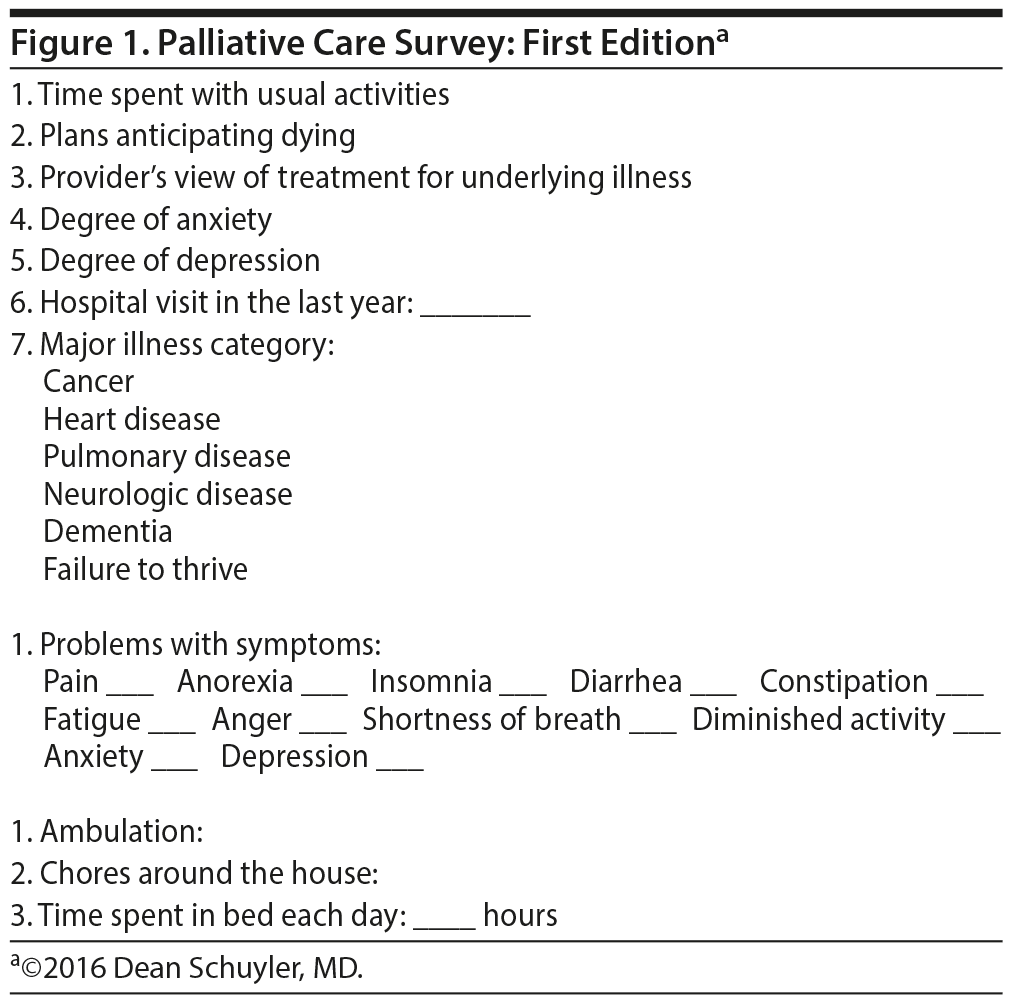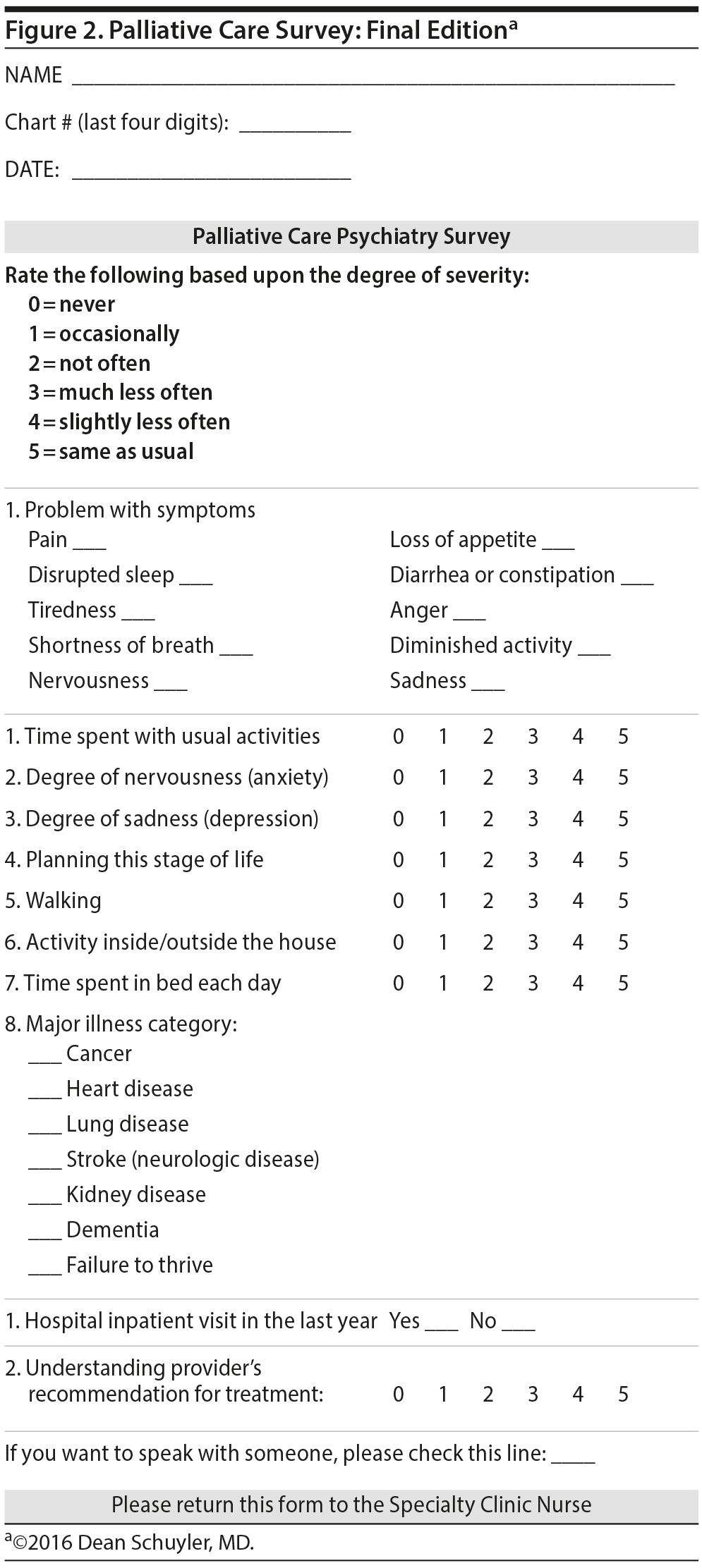Because this piece does not have an abstract, we have provided for your benefit the first 3 sentences of the full text.
To the Editor: I have worked for more than 6 years as a psychiatrist on a palliative care team at the Ralph H. Johnson Veterans Administration (VA) Medical Center in Charleston, South Carolina. Early on, while reading to learn about palliative care, it became clear to me that referrals from health care professionals to palliative care were seen as coming much too late. It seems that many health care providers believe in palliative care for their patients but save the referral until they feel that there is nothing more they can do for the patient.

When to Refer to Palliative Care

EDITOR’ S NOTE
Through this column, we hope that practitioners in general medical settings will gain a more complete knowledge of the many patients who are likely to benefit from brief psychotherapeutic interventions. A close working relationship between primary care and psychiatry can serve to enhance patient outcome.
Dr Schuyler is a psychiatrist and a member of the palliative care team at the Ralph H. Johnson Veterans Administration Medical Center, Charleston, South Carolina.
Prim Care Companion CNS Disord 2016;18(6):doi:10.4088/PCC.16f02074
© Copyright 2016 Physicians Postgraduate Press, Inc.
Published online: December 29, 2016.
Corresponding author: Dean Schuyler, MD, Geriatrics/Extended Care, Ralph H. Johnson Veterans Administration Medical Center, Charleston, SC 29401 ([email protected]).
Funding/support: None.
Potential conflicts of interest: None.
Disclaimer: The views expressed are those of the author and do not necessarily reflect the views of the Veterans Administration.
I have worked for more than 6 years as a psychiatrist on a palliative care team at the Ralph H. Johnson Veterans Administration (VA) Medical Center in Charleston, South Carolina. Early on, while reading to learn about palliative care, it became clear to me that referrals from health care professionals to palliative care were seen as coming much too late. It seems that many health care providers believe in palliative care for their patients but save the referral until they feel that there is nothing more they can do for the patient.
People who provide palliative care suggest that the referral should come much earlier in the patient’s course of illness. It is best that the referral occur at the time of diagnosis of a severe medical illness. Short of making this point multiple times in training, it has been difficult to make this change. Palliative care is an integral part of the treatment package needed by many patients. It consists of concerns about pain, anorexia, insomnia, bowel function, fatigue, anger, shortness of breath, activity, anxiety, and depression.
One useful approach might involve the creation of a scale score that would point to the appropriateness of palliative care for a patient. The director of geriatrics at the VA hospital (Cheryl Lynch, MD, MPH) tasked me with the development of such a scale. Several of the scale items have already been specified by patients I have interviewed at the end of life. When patients have a major medical illness, they typically decrease the time spent in usual activities and spend more time thinking about the illness and its consequences. This thinking may generate anxiety. They also may become depressed, with sleep disruption, appetite loss, weight loss, anergia, increased fatigue, and loss of memory—all symptoms of depression.
The patient may not understand his or her provider’s recommendation for treatment. Often, the diagnosis of a major illness ushers in a new stage of life. How that life stage is planned becomes an important piece of the patient’s adjustment. Walking and other activities are often reduced. For some, there is a marked increase in time spent in bed, further curtailing the amount of time allocated for other activities.
To create a survey, I listed several of these items that seem to define the need for palliative care. My intention was to survey the various patients who attend our VA hospital clinics. The result was the first edition of the new survey (Figure 1). Next, I showed the survey to several health care providers on our team. I was told by several nurses that there was no time available for them to interview each outpatient and then complete the survey. Therefore, it would need to be a subjective scale (given to the patient) rather than an objective scale (completed by a staff person). In addition, the survey would require items whose definitions would be readily understood by clinic patients. There should also be a statement on the form directing a participant to return the completed form to a health care provider. Staff also indicated that graded responses should be available to help a researcher discriminate answers to the questions posed.
When I showed the form to the head of our oncology clinic (Rinah Shopnick, DO), she pointed to the item "plans anticipating dying" and told me that it made her nervous. Likely, she said, it would make patients nervous too and should be changed. When I was told that the survey should include a place for participants to indicate that they would like to speak with someone on the staff about their illness in addition to their provider, I agreed. Thus, the form should make room for the patient’s name and chart number to facilitate this referral.
Now, the survey was ready for distribution (Figure 2 provides the final format). Quickly, 150 surveys were filled out by outpatients and turned in to staff. One of our staff members expressed interest in working on this project (Clark Alsford, MD). It seemed that a quantitative score might provide a result that would cue the provider to make a referral to palliative care. I will write more about the project as the work is accomplished.
Please sign in or purchase this PDF for $40.00.
Save
Cite


